By Giovanni Pallotta
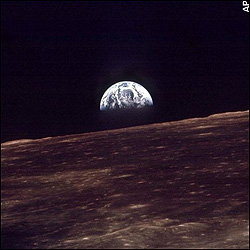 Today it is impossible to think of any scientific discovery that is not communicated via Internet. In this manner, millions of scientists and science-lovers are made aware of discoveries and new conquests almost live, with the use of videos that are ready to show in minute detail the latest developments in every scientific sector. As we well know, mankind has not always been this fortunate in terms of communications and often scientific discoveries were made available only to small groups of elite scholars, who in any case were never updated immediately. Paradoxically speaking, sometimes the diffusion of the discovery was more complicated than the discovery itself, physical distances and language barriers were sometimes the most difficult obstacles to overcome.
Today it is impossible to think of any scientific discovery that is not communicated via Internet. In this manner, millions of scientists and science-lovers are made aware of discoveries and new conquests almost live, with the use of videos that are ready to show in minute detail the latest developments in every scientific sector. As we well know, mankind has not always been this fortunate in terms of communications and often scientific discoveries were made available only to small groups of elite scholars, who in any case were never updated immediately. Paradoxically speaking, sometimes the diffusion of the discovery was more complicated than the discovery itself, physical distances and language barriers were sometimes the most difficult obstacles to overcome.
The event that marked the turning point in the field of scientific communications took place during the so-called, “Space Race,” in other words that particular historic moment that coincided with the imposing development of human knowledge regarding space and celestial bodies. The “Space Race” was seen not only as a genuine quest for knowledge, but it soon became a “battlefield” of ideologies between the two superpowers at that time to emerge at the end of World War II: the United States of America and the Union of the Soviet and Socialist Republic. A true and authentic scientific war fought on two fronts: scientific progress on one hand and the communication of such accomplishments on the other hand. Both Washington, D.C. and Moscow tried in every possible way to boldly proclaim the scientific achievements of their own nation. We can say that the posters which announced such scientific achievements played a very significant role in communications before the advent of television.
In order to understand the importance of the “Space Race,” it is necessary to place ourselves in the historical and political context following World War II. In 1945, the Americans having dropped atomic bombs on Hiroshima and Nagasaki, decreed the end of the Second World War and showed the whole world their immense military and above all scientific supremacy. On the other hand, the Soviets, did not waste time and immediately started an impressive scientific research programme which led to creation of the first Soviet atomic bomb, thanks to the “collaboration” with Nazi scientists and the theft of American knowledge and documents. The knowledge of the fact that the “Atomic Bomb” formulas were also in the hands of the Soviets caused a great feeling of panic among the Americans who subsequently decided to increase their production of nuclear arms. In this manner, the two world superpowers began a constant escalation of nuclear arms that brought about the accumulation of enormous nuclear arsenals, with the force to cause terrible damage to the whole world. Once the projects regarding nuclear arms were completed, the attention on military strategies inevitably moved towards gaining knowledge on the place/places to launch atomic weapons. So with the passing of time, it became more and more necessary to learn about outer space, seen as an area for military manoeuvres and experiments of utmost importance. A need for to learn about outer space also led to the construction of better built and more powerful atomic arms. From this military starting point , research was also conducted that enabled man to conquer space. The USSR was the first nation to send man into space. In 1961, Yuri Gagarin on the spaceship Sputnik was the first man to go into orbit around the Earth. It took the United States eight years to match and pass the Soviet move, so in 1969 in the spaceship called Apollo 11, Neil Armstrong was the first man to land on the Moon. The battle between the two superpowers regarded not only scientific supremacy but also ideological and communicative dominance. Differences in terminology immediately emerged, for example the Soviets preferred the term, “Cosmonaut,” while the Americans coined the work, “Astronauts.” This may appear as a subtle lexical variation, but it actually underlines the deep ideological differences that separated the two blocs.
The communications departments from both the Soviet and the American blocs worked just as hard as the scientific research teams to announce to the rest of the world the progress that each side had been making in the Space Race. Many different means of communications were used. The Americans were actually able to broadcast Neil Armstrong’s historical landing on the Moon live, thus forever changing the concept and procedure of how events would be transmitted in the future. Even though, television broadcasting was the most obvious means in this subtle war of communications. Exchanges also took place using other means, such as press releases issued from the various press agencies and most insidiously through the use of posters which were tangible proclamations that announced the various scientific developments that were taking place on both parts.
The Soviets, confident due to the fact that they had been the first to send a man into space took a psychological advantage of their supremacy by using very aggressive forms of communications towards the Americans. However, it is interesting to note that the counter attacks by the United States and the National Aeronautics Space Agency (NASA) were just as strong.
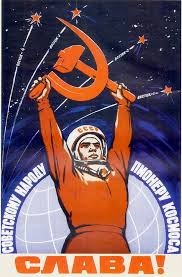 In the poster n.1, the public could see that the globe (recognizable by the meridians and parallels designed), surrounded by outer space (understood by the representation of many stars). In the foreground, we see the triumphant pose of a gigantic Soviet cosmonaut announcing Soviet power and supremacy. It is interesting to focus on the cosmonaut’s expression- it is not a look of neither joy, nor awe nor incredulity but it is one of a person who knows and recognizes his own strength and power. He is not smiling; he is simply telling the world that he knows that the mission that had been set by the Soviets has been accomplished and that the Soviet bloc is ahead of the Americans. We can say that he is gloating about his country’s accomplishments. In this context, the point is clear, starting with the symbol of the Communist party , in other words the hammer and the sickle that stand out in the image. The two symbols emerge in the Cosmonaut’s taut muscles which underline the strength of the Russian people, who with their predominance will take Communism to heights that had never been reached before that moment; making it a type of world symbol (if we look carefully, we can see that the two symbols were placed ABOVE the earth and this was done with purpose). The image is then completed with a caption in Cyrillic that encompasses the world which states, “long life to the Soviet population, the space pioneers!” The message that Soviet opinion makers wanted to diffuse was very clear; the presence of Yuri Gagarin in orbit was not his own personal victory nor was it the victory of the scientific team that worked on the project, but it was the victory of the whole Soviet population. Upon a closer look at the poster, it is important to reflect on the cosmonaut’s face. He cannot be recognized, he does not depict a specific person, but he represents the whole community of the Soviets that has imposed its scientific discoveries on the rest of the world.
In the poster n.1, the public could see that the globe (recognizable by the meridians and parallels designed), surrounded by outer space (understood by the representation of many stars). In the foreground, we see the triumphant pose of a gigantic Soviet cosmonaut announcing Soviet power and supremacy. It is interesting to focus on the cosmonaut’s expression- it is not a look of neither joy, nor awe nor incredulity but it is one of a person who knows and recognizes his own strength and power. He is not smiling; he is simply telling the world that he knows that the mission that had been set by the Soviets has been accomplished and that the Soviet bloc is ahead of the Americans. We can say that he is gloating about his country’s accomplishments. In this context, the point is clear, starting with the symbol of the Communist party , in other words the hammer and the sickle that stand out in the image. The two symbols emerge in the Cosmonaut’s taut muscles which underline the strength of the Russian people, who with their predominance will take Communism to heights that had never been reached before that moment; making it a type of world symbol (if we look carefully, we can see that the two symbols were placed ABOVE the earth and this was done with purpose). The image is then completed with a caption in Cyrillic that encompasses the world which states, “long life to the Soviet population, the space pioneers!” The message that Soviet opinion makers wanted to diffuse was very clear; the presence of Yuri Gagarin in orbit was not his own personal victory nor was it the victory of the scientific team that worked on the project, but it was the victory of the whole Soviet population. Upon a closer look at the poster, it is important to reflect on the cosmonaut’s face. He cannot be recognized, he does not depict a specific person, but he represents the whole community of the Soviets that has imposed its scientific discoveries on the rest of the world.
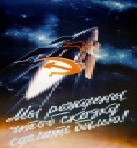 The Soviet propaganda machine however, could be even more straightforward. The second poster was issued on the third anniversary of the Sputnik launch and it shows a Sputnik (soviet spaceship whose propulsion comes from the symbol of the regime, the ever present hammer and sickle). The spaceship leaves behind a “hot spot” which we presume is well-known and recognized and it propels itself with great arrogance towards the unknown world of outer space. The writing or caption, in cursive Cyrillic script states, “We were born to make your dreams come true.” The dreams that the poster cites seem quite obvious, in other words the conquest of outer space. However, upon a closer look, we can interpret the caption in another way, in other words, the dream of uniting the world under the command of Communism[1]. So we can say that the missile does not depart from a specific geographical area but from an indistinct orange-colored mass, that represents the planet Earth. Above the Earth we find the rising imperial and imposing symbol of Communism itself, projected towards a new era and towards a new future after having resolved the conflicts on the planet Earth, making it a safe and peaceful place to live.
The Soviet propaganda machine however, could be even more straightforward. The second poster was issued on the third anniversary of the Sputnik launch and it shows a Sputnik (soviet spaceship whose propulsion comes from the symbol of the regime, the ever present hammer and sickle). The spaceship leaves behind a “hot spot” which we presume is well-known and recognized and it propels itself with great arrogance towards the unknown world of outer space. The writing or caption, in cursive Cyrillic script states, “We were born to make your dreams come true.” The dreams that the poster cites seem quite obvious, in other words the conquest of outer space. However, upon a closer look, we can interpret the caption in another way, in other words, the dream of uniting the world under the command of Communism[1]. So we can say that the missile does not depart from a specific geographical area but from an indistinct orange-colored mass, that represents the planet Earth. Above the Earth we find the rising imperial and imposing symbol of Communism itself, projected towards a new era and towards a new future after having resolved the conflicts on the planet Earth, making it a safe and peaceful place to live.
After suffering such an affront, the Americans commenced their counter-attack. It began with President, John F. Kennedy’s speech in 1962 where he declared: “We choose to go on the moon in this decade and do the other things, not because they are easy, but because they are hard, because that goal will serve to organize and measure the best of our energies and skills, because that challenge is one that we are willing to accept, one we are unwilling to postpone, and one which we intend to win, and the others, too.”[2]
Obviously, following Kennedy’s speech, NASA knew that they could no longer make any mistakes and succeeded in the feat that represented the apex of the so-called “space race,” in other word, putting man on the Moon.
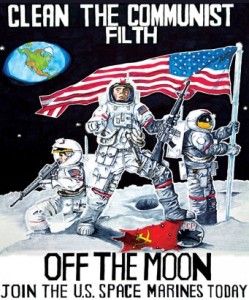 This time it is the Americans turn to issue a victory poster. The message that the American poster represents their supremacy over the Soviet forces, who had failed in their endeavor. As we can see in poster number 3, the image celebrates Man’s landing on the Moon. We immediately note the aggressiveness of the image. The three astronauts are standing in a warrior-like position after winning a victory on a battlefield; two of them are holding rifles, while the third one is engaged in planting the American flag on lunar soil, obviously after having removed and ripped up the Soviet banner. In the distance, we can see the Earth and we can clearly identify the North American continent, the homeland of the victorious soldiers involved in the fight against Communist forces. There is no need to interpret the caption as it is self-explanatory, clear and highly aggressive towards the Communists. The Moon must be saved from Communist threat and in order to do this, the only solution is the presence of the invincible US SPACE MARINES. In the poster, we can almost feel the United States pride, the flying flag is the perfect testimonial in the fact that the nation was able to win forever the scientific battle against the enemy. It represents a county that is ready to fight its enemy on any field and in any sector especially when the nation’s superiority is questioned. Adversaries are eliminated without any mercy. To continue the parallelism between American and Soviet propaganda (communications) it is also correct to take into consideration the commemorative poster of the 1969 accomplishment, as we looked at the Sputnik success in an earlier paragraph of this paper.
This time it is the Americans turn to issue a victory poster. The message that the American poster represents their supremacy over the Soviet forces, who had failed in their endeavor. As we can see in poster number 3, the image celebrates Man’s landing on the Moon. We immediately note the aggressiveness of the image. The three astronauts are standing in a warrior-like position after winning a victory on a battlefield; two of them are holding rifles, while the third one is engaged in planting the American flag on lunar soil, obviously after having removed and ripped up the Soviet banner. In the distance, we can see the Earth and we can clearly identify the North American continent, the homeland of the victorious soldiers involved in the fight against Communist forces. There is no need to interpret the caption as it is self-explanatory, clear and highly aggressive towards the Communists. The Moon must be saved from Communist threat and in order to do this, the only solution is the presence of the invincible US SPACE MARINES. In the poster, we can almost feel the United States pride, the flying flag is the perfect testimonial in the fact that the nation was able to win forever the scientific battle against the enemy. It represents a county that is ready to fight its enemy on any field and in any sector especially when the nation’s superiority is questioned. Adversaries are eliminated without any mercy. To continue the parallelism between American and Soviet propaganda (communications) it is also correct to take into consideration the commemorative poster of the 1969 accomplishment, as we looked at the Sputnik success in an earlier paragraph of this paper.
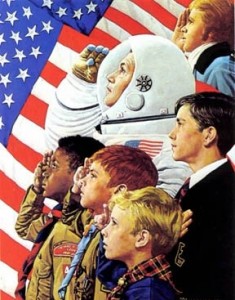 Poster number 4 represents the final results of the concepts previously stated in poster number 3, in other words, in the long run, the United States always win. This poster is highly significant, in the background we can see the waving American flag, while in the foreground we can see six figures, in the right we can see one of the American founding fathers recognizable from his style of clothing and hairstyle, telling the viewer that America’s past is a vital part of the country’s present. In the lower left-hand corner, we can see young people and children that represent America’s future; it is important to highlight that among the children there is a black child, that exemplifies the fact that the United States is the land of opportunity for all. In the center we see the States’ present, in other words the country’s victory in the “Space Race.” A soldier is shown saluting the flag. All the figures are gazing upwards in a trusting way, aware of the fact that the nation’s future will be full of glory and victory in the eternal battle against the forces of evil, that is to say the Soviet forces. It is a poster that makes a strong impact on viewers, there is no need for a caption as we saw in the previous three posters that we took into consideration and analysis. This poster shows the majesty, the power and the history of the Nation, without wasting time to give explanations that in any case would appear superfluous. In order to understand what the United States represent, the viewer only needs to look at the Nation’s flag, past, present and future in its most splendid form.
Poster number 4 represents the final results of the concepts previously stated in poster number 3, in other words, in the long run, the United States always win. This poster is highly significant, in the background we can see the waving American flag, while in the foreground we can see six figures, in the right we can see one of the American founding fathers recognizable from his style of clothing and hairstyle, telling the viewer that America’s past is a vital part of the country’s present. In the lower left-hand corner, we can see young people and children that represent America’s future; it is important to highlight that among the children there is a black child, that exemplifies the fact that the United States is the land of opportunity for all. In the center we see the States’ present, in other words the country’s victory in the “Space Race.” A soldier is shown saluting the flag. All the figures are gazing upwards in a trusting way, aware of the fact that the nation’s future will be full of glory and victory in the eternal battle against the forces of evil, that is to say the Soviet forces. It is a poster that makes a strong impact on viewers, there is no need for a caption as we saw in the previous three posters that we took into consideration and analysis. This poster shows the majesty, the power and the history of the Nation, without wasting time to give explanations that in any case would appear superfluous. In order to understand what the United States represent, the viewer only needs to look at the Nation’s flag, past, present and future in its most splendid form.
Having given a brief analysis of the various images, we can now look at analyzing the similarities and differences between them. First of all, both the American and the Soviet posters are characterized by a heavy use of political symbols: the hammer and sickle on one hand and the Stars and Stripes on the other. Both emphasize the main characters involved in the Space Race, in other words the astronaut or in Soviet terms, the cosmonaut.
Let’s now look at some differences, for the Russians, the cosmonaut represents the population (the face is unrecognizable), for the Americans the astronaut is a part of society, in other words, a warrior who has been called upon to fight in a war for scientific and technological supremacy. Hidden behind this initial observation is the basis in itself for the ideological differences between the two super powers. On one hand, man is seen in his totality and therefore a metaphor of his nation which is united in imposing its scientific knowledge on others. While on the contrary, the Americans give importance to the individual, first seen as a warrior and then as an example for future generations.
At a first glance, what appears to be a slight difference actually sums up eloquently the main differences of the opposing ideologies. Another difference that emerges regards the use of colors and light/shadow images. In the Soviet posters the image is clear, surrounded by celestial obscurities, almost underlying the efforts made by the Russians to guarantee their cultural superiority. However, in the American posters, brilliant colors (reds, oranges and blue) are used to recall the feeling of celebration to underline the Americans pride in obtaining their victory and their first step on the Moon.
In conclusion, each nation tried to assert its supremacy using every available means. In particular, communications and mass media were the best method to make any message readily widespread. Through the use of posters that concentrated on the “Space Race,” both the Soviets and the Americans also wanted to diffuse not only their scientific advancements, but to also communicate their ideological differences. This means of communications was extremely effective in a period spanning from the late 1950s to the early 1970s when diffusing a message was so much more complex than it is today. Posters were immediate and clearly delivered their message using symbols that were readily understood by millions. In today’s face paced communications industry, those posters would have very little influence or impact, but at that time in history they were the most efficient and effective means of conveying the countries’ messages, both in terms of scientific discovery and above all in terms of ideologies.
Giovanni Pallotta
[1] The exporting of Communism in the world is the main aim of Soviet policy since
the days of Trotsky (1879-1940)
[2] John F. Kennedy, Speech at Rice University, Houston, September 12, 1962
Foto: il Pianeta Terra è del Telegraph, le lmmagini dei poster sono state fornite dall’autore





